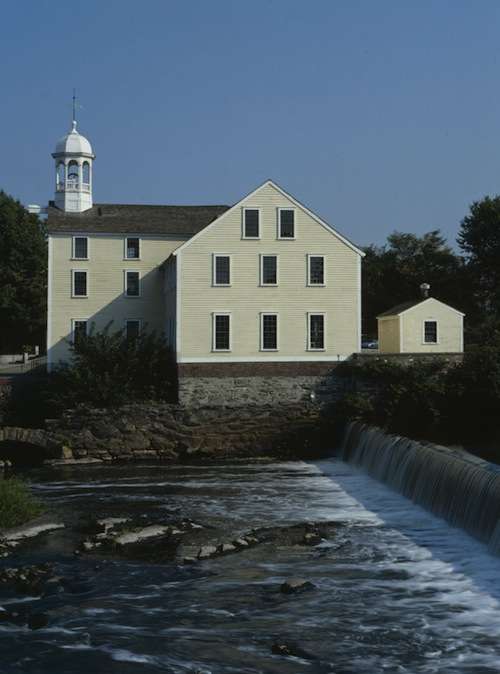America’s first factory strike happened just 30 years after America’s first successful textile mill started churning out cotton cloth in Pawtucket, R.I.
It was May 1824, and the mill owners in the burgeoning industrial city had made an announcement.

Sam Slater’s mill. first in the U.S. Photo courtesy of the Library of Congress.
They planned to increase the workday by one hour and cut wages by 25 percent for power loom weavers – that is, for women between the ages of 15 and 30. They were, after all, earning “extravagant” wages – according to the mill owners.
On May 26, 1824, 102 young women along with sympathetic community members blocked the entrance to Sam Slater’s textile mill, shutting them down. The strike spread to other mills.
The Pawtucket Journal reported:
On Wednesday evening a tumultuous crowd filled the streets, led by the most unprincipled and disorderly part of the village, and made an excessive noise — they visited successively the houses of the manufacturers, shouting, exclaiming and using every imaginable term of abuse and insult. The window in the yellow mill was broken in. … The next day the manufacturers shut their gates and the mills have not run since.
The Textile Industry Takes Hold
Sam Slater gets credit for starting the Industrial Revolution in America because he built his water-powered textile mill in 1793. Similar textile mills then sprang up along the Blackstone River and beyond. Industrialization got further boosts from the Embargo of 1809 and the Tariff of 1816, which protected U.S. textiles from British imports. By the Civil War, textiles were America’s most important industry.

Sam Slater
Along with the modern factory, Slater also introduced child factory labor to America. He would seek out children aged 7-13 from poor white families. Then he’d hire them for 40 cents to 60 cents a week. They worked 12- hour days in winter, 16 in summer. Many children hated working in the gloomy and dangerous mills, and some ran away. Their parents sometimes took them away from work because they wanted them to earn higher wages.
Slater also hired entire families, putting them in company housing and forcing them to shop at the company store.
He and other mill owners found workers harder and harder to control. Some sabotaged the factories, stealing property and setting fires. Some showed up late. And some didn’t show up at all.
In 1814, the Pawtucket mill owners petitioned the state Legislature to organize a police force as ‘it has often been found difficult to preserve order and due subordination.’
Slater had another method. He introduced Sunday school for children, who, after working six 16-hour days could get indoctrinated in the Christian virtue of hard work and submissiveness.
1824 Factory Strike
After about 1810, Slater could no longer rely on child labor because he started using the power loom. The machinery was too much for young children, so to run them he hired the second-cheapest workers: young women.
But the ladies proved less submissive than the mill owners hoped. When the Pawtucket factory owners announced the pay cut and the longer work day, the women decided to have none of it.
At the Slater mill, 102 young women started the strike – then called a turnout.
The strike spread to seven other mills, and 500 workers walked off the job. And they didn’t just shut down the mills. They went to the owners’ houses, shouted insults at them and broke their windows. A local judge wrote that the streets were, ‘literally filled with Men Women and Children — making a mob of very daring aspect, insulting the managers of cotton mills in every shape — pulling and hauling — screaming and shouting thro the streets.’
On the last day of the strike, one of the mills burned down in a fire probably set by a striker. The owners agreed to a compromise, the details of which are lost to history. On June 3, the strikers returned to work.
Aftermath of the Factory Strike
We know little of the factory strike from the women’s point of view. But the Pawtucket strike set off a wave of labor organizing in Pawtucket and across the region. In Lowell, Mass., for example, the mill girls went on strike in the 1830s. They also went on factory strikes in Providence, Waltham and Woonsocket, in Lynn, Mass., and in Brunswick, Maine, to name a few.
Child labor would persist, however, as documented by photographer Lewis Hine. In 1938, Congress outlawed child labor, but women still struggle for equal pay.
Image of the Slater Mill (rear view) By Kenneth C. Zirkel – Own work, CC BY-SA 4.0, https://commons.wikimedia.org/w/index.php?curid=72955211. This story was updated in 2023.


3 comments
Roseway – Wikipedia
https://en.m.wikipedia.org/wiki/Roseway
The Roseway is a historic schooner the last surviving one built in Ipswich MA.
It also served as the Boston Harbor Pilot Boat. Was refurbished and today is a teaching vessel for the Ocean Maritime School in ME. Summer moores in Boston and winters in the Carribean.
[…] direct action, along with less peaceful demonstrations. In what was likely the nation’s first factory strike of the industrial period, women mill workers in Pawtucket, Rhode Island, set fire to a factory and […]
[…] first major factory strike of the Industrial Revolution (in the United States) took place in 1824, the […]
Comments are closed.